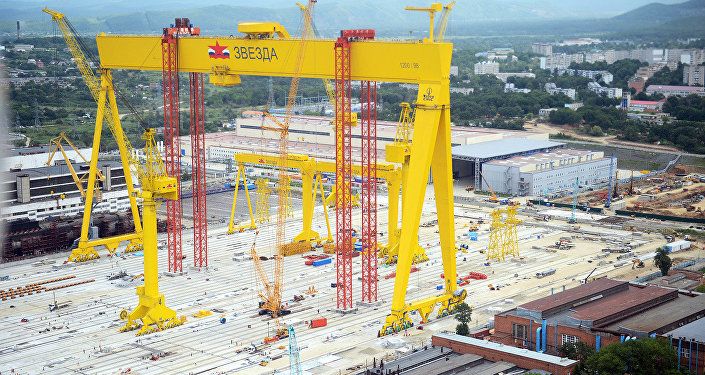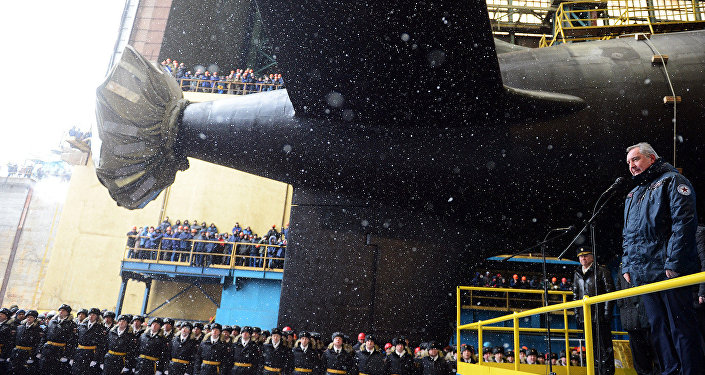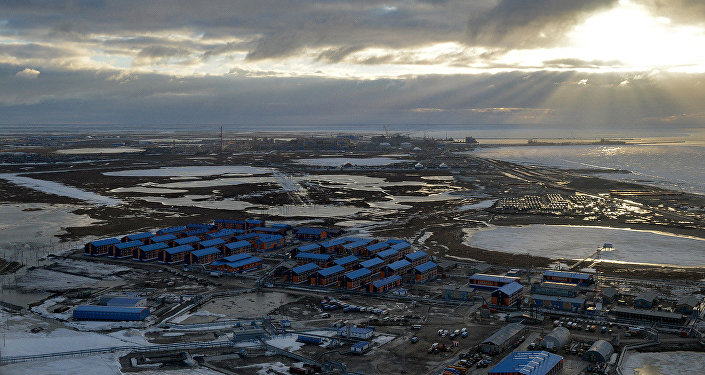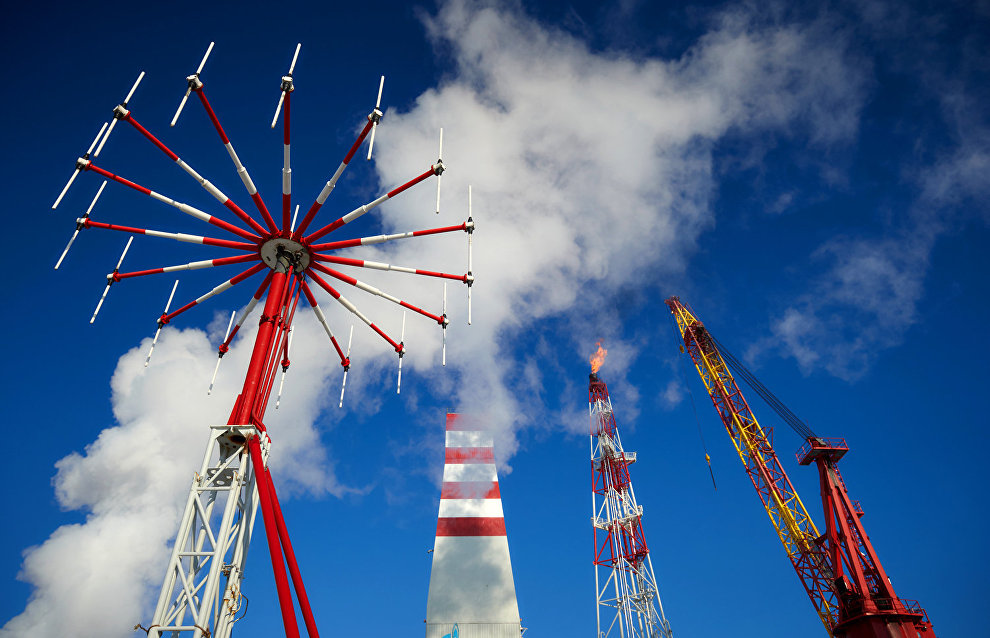Arseny Mitko: Oil and gas sector launches import substitution program
Russia has no domestic capacities for building self-docking and semi-submersible drilling and production platforms, underwater production complexes, 3D seismic reconnaissance equipment or supply vessels. Thus, Gazprom and Rosneft have suspended exploratory/wildcat drilling operations in their respective licensed sectors of the Arctic shelf.
Rosneft, Gazprom, LUKOIL and NOVATEK which have mostly preferred foreign technologies now completely depend on imported oil and gas equipment.
Today it is necessary to use our though inadequate forces and resources on reviving a domestic industry that can provide the Russian oil and gas sector with the required equipment. Russia boasts such companies. The Arkticheskaya self-docking floating drilling rig and the Prirazlomnaya high-seas ice-resistant stationary platform were built in Severodvinsk. LUKOIL's corporate plant in Astrakhan developed drilling platforms for the Caspian Sea, and those for the Baltic Sea were developed at its Kaliningrad plant. A high-seas ice-resistant oil terminal for the Varandei field in the Pechora Sea was also built here. Russia can accomplish anything if it wants to.
The comprehensive implementation of these measures could help reduce the share of imports from 60 to 43 percent by 2020 under target parameters. The Science and Technology Council for the Development of Oil and Gas Equipment is an important element in this. This Council helps the concerned parties to communicate and synchronize investment projects of Russian oil and gas companies acting as clients and the potentialities of national engineering manufacturers.
Unfortunately, Russia has so far failed to start developing cutting-edge shelf technology even though this is stipulated by the federal targeted program Development of Civilian High-Seas Equipment. This equipment is to be developed by United Shipbuilding Corporation companies.
Today, 90 percent of the equipment used in shelf projects is Western equipment and technology. Over 200 Russian companies manufacture oil and gas related equipment, but they would only be able to deliver the needed equipment samples to the industry in 2018-2020 if they start on these projects today.
In November 2014, Russian President Vladimir Putin chaired a meeting of the Government Commission on the Fuel and Energy Sector and instructed the concerned officials to draft an import substitution program in early November. The Ministry of Industry and Trade later submitted a program with 45 import substitution sections to the Russian Government. Russian Prime Minister Dmitry Medvedev visited the Zvezda (Star) Shipyard, a planned leading manufacturer of sea-going vessels. He said it was necessary to build all three stages of the shipyard.
"I believe all three construction stages must be completed otherwise the project will fail to produce any results," he said in Vladivostok.

© RIA Novosti. Sergei Mamontov
Gazprom and Rosneft can place contracts worth about four trillion rubles and stipulate construction of drilling platforms, supply vessels and tankers at Zvezda
through 2030. Potential clients include LUKOIL and other industry companies.
Norway's national strategy
Russia should look to international experience, including that of Norway, for establishing its own industry that can manufacture equipment for shelf projects. While cooperating with foreign companies, Norway expected its foreign partners to train personnel and relocate production to the country. This relocation into Norway has increased from 10 percent to 95 percent. Today, technologies for oil and gas shelf projects total one-third of Norwegian exports.
It took Norway about 50 years to drill over 3,000 wells on the continental shelf and to discover about 70 deposits. By using the experience of US companies, by skillfully investing petrodollars, the country established a cost-effective oil and gas industry in minimal time. It also developed unique production complexes, some that can pump underwater hydrocarbons.
Norwegian companies lead the way on the global market of underwater and drilling equipment, floating oil production, storage and shipment systems and in the service sector. Norway has managed to create a unique cooperation model involving oil and gas companies, providers of equipment and services that are members of the INTSOK (Norwegian Oil and Gas Partners) organization, as well as research and development agencies.
In the past 20 years, Norway has financed the discovery of new deposits and projects to upgrade technologies that have made it possible to boost the oil yield of working seams and to extract 65 percent of the oil content. No other country has so far managed to surpass this.
It should be noted that the Research Council of Norway supports companies that invest in innovative programs and research and development projects. Industrial projects are supported under a tax program called SkatteFUNN that incentivizes development through tax concessions.
In 2001, Norway passed its national strategy, Oil and Gas in the 21st Century, that charted eight target research areas, including environmentally friendly technologies for the future, comprehensive research of deposits and geological prospecting, efforts to improve oil production technologies, cost-effective drilling, integrated production and real-time seam development, underwater processing and transportation, deep-sea and underwater production and gas technologies. Norway has thus successfully developed state-of-the-art production equipment and maintained its national oil and gas industry's competitiveness.
Hopefully, Russia will take advantage of this experience, its oil and gas sector will stop relying so heavily on foreign-made equipment and will use Russian-made equipment on the Arctic shelf.
Murmansk technologies
Murmansk can and must become the main city in charge of developing the Arctic shelf and a major center for manufacturing high-seas production equipment. During the Soviet era, various companies working on the Arctic shelf, including Arktikmorneftegazrazvedka, Sevmorneftegeofizika, High-Seas Arctic Geological Expeditions, and Arctic High-Seas Engineering Geological Expeditions, were established in Murmansk. These companies discovered almost 20 oil and gas deposits, including unique deposits. For example, the Shtokmanovskoye field contains an estimated 3.7 trillion cubic meters of gas or more than all gas reserves of Norway.
After the Soviet Union, Gazprom divisions, including Gazprom Dobycha Shelf, Gazprom Dobycha Neft and Gazflot, settled down in Murmansk. Gazflot operates the Polyarnaya Zvezda (Polar Star) and Severnoye Siyaniye (Aurora Polaris) semi-submersible drilling rigs, the Arkticheskaya and Amazon self-mooring drilling rigs and the Obsky drilling system for shallow waters. Gazflot has established a coastal supply base here, and there are plans to set up Rosneft's coastal base to support its shelf projects.
NOVATEK is planning to build a center for assembling high tonnage ocean structures in the town of Belokamenka. To support the company, the government passed a directive on June 17, 2015 approving a plan of high-priority measures to build the above center. The project is currently worth an estimated 25 billion rubles. The center would employ over 3,000 workers if it attains maximum design capacity. NOVATEK has registered the Kola Shipyard's 100-percent subsidiary in Aleksandrovsk, a closed administrative-territorial unit in the Murmansk Region.
NOVATEK CEO Leonid Mikhelson said his company and Norway's Kvaerner were discussing a concept to set up production facilities for long-term liquefied natural gas (LNG) production projects in the Murmansk Region. The Kola Shipyard is conducting surveying operations at the future shipyard site. The project is in its pre-investment phase, and they plan to complete an investment feasibility study by late 2018. If everything goes well, construction of the shipyard could be launched in 2019.
In 2014, Gazpromneft-Sakhalin established a supply base at Murmansk Commercial Seaport for providing trial drilling in the Pechora Sea. The company considers the port of Murmansk to be a potential and promising base for operations on the Arctic shelf.
Russian companies can follow the lead of Norwegian company Reinertsen that built a plant in the town of Abram-Mys in minimal time. This plant, that employs Russian specialists, has been assembling metal structures for the underwater development of hydrocarbon deposits on the Arctic shelf for the past few years.
The Vyborg Shipyard, Yantar in Kaliningrad, St. Petersburg's Northern Shipyard, Sevmashpredpriyatiye and Zvyozdochka in Severodvinsk and the Astrakhan Shipyard boast this experience, and they could build high-seas drilling platforms for shelf projects in Russia.

© RIA Novosti. Sergei Mamontov
We need modern technologies, innovative engineering, research and development projects, funding from the state and oil and gas companies, as well as tax subsidies and incentives.
The Port of Sabetta project is not just about building a local port. This project helps award contracts to other companies and facilitates development. Uralmash is manufacturing its unique Arktika drilling rigs for the project. The Ural Pipe Plant delivers pipes, with the Yamal and Utair airlines delivering consignments. Kurgan and Tyumen, Chelyabinsk and Yugra deliver goods and services and contribute their research projects and workforce.
In the past few years, the Russian authorities have passed a number of important state documents setting forth various aspects and prospects for the well-balanced development of Russia's Arctic zone. They include the Strategy for the Socioeconomic Development of the Russian Arctic Zone and Maintaining National Security until 2020.
Import substitution is underway
Today, if one can say that Russia has launched an intensive import substitution program, it really takes place in its oil and gas sector which was the hardest hit by sanctions. Understandably, Russia needs to do this because oil and gas exports account for two-thirds of the country's export revenues and about 50 percent of the federal budget. About 300 Russian companies are to join the import substitution program.
LUKOIL that performs annually 700-800 operations to introduce new Russian equipment is a case in point. Gazprom Neft has also started introducing Russian-made technologies more actively.
United Heavy Machinery Plants is the first national company to start manufacturing natural gas liquefaction plants on a turnkey basis and providing warranty and post-warranty maintenance. This year, UVZ-Neftegazservice will launch production of drilling rigs with a load-carrying capacity of 120 metric tons for the first time, (Russia now mostly uses Chinese-made drilling rigs.)
Unfortunately, corrupt or biased managers at oil and gas companies dealing with national producers are the main obstacle to import substitution. Unpredictable taxation is another issue.
Purchasing Western bank loans remains a slim possibility due to the sanctions. In addition, Russian oil and gas companies have accumulated massive debt, and this could negatively affect investment programs.
Gazflot continued to drill wells on the Sakhalin shelf under a contract with Gazprom Dobycha Shelf. The Polyarnaya Zvezda (Polar Star) and Severnoye Siyaniye (Aurora Polaris) semi-submersible drilling rigs were used for these purposes.
An underwater gas production technology has been used to develop the Kirinskoye gas field on the Russian shelf for the first time. This technology helps pump the gas from the wells directly ashore without any structure above the water and makes it possible to produce hydrocarbons even beneath ice formations and minimizes environmental impact.

© RIA Novosti. Sergei Mamontov
Russian technologies were mostly used to build facilities of the coastal technological complex. National companies have designed and manufactured complicated technological equipment for ensuring the uninterrupted operation of the underwater production complex. A gas and gas-condensate preparation unit also features Russian-made equipment. Rosneft also conducted drilling operations on the Sakhalin shelf. The company uses offshore and high-seas drilling rigs here. The Yastreb (Hawk) ground-based drilling rig, one of the most powerful rigs in the oil and gas sector, can drill in non-vertical patterns. The Orlan (Bald Eagle) high-seas platform includes a steel-and-concrete structure with drilling and habitation modules and can withstand pack ice and huge hummocks.
Russia has always boasted production technologies for the off-shore production, and these technologies must now be revived. Today, we need to know how quickly the domestic industry can develop the technologies and equipment for implementing new Arctic projects in collaboration with China, India and Korea, rather than our "friends" from the United States and Europe.
Russian industry possesses experience in building sophisticated deep sea equipment that prospects for and produces gas and oil on the shelf. The United Shipbuilding Corporation is completing the ice-resistant stationary platform No. 1 for the Filanovsky field under contract with LUKOIL. This platform was built at the Astrakhan Shipbuilding Production Association (affiliated with "Kaspiiskaya Energiya", CNRG group.)
Russian oil and gas companies will drill 36 wildcat and 15 exploratory wells, to study 193,000 running kilometers of 2D seismic data images and 39,000 square kilometers of 3D data images through 2020. To accomplish all these tasks, Russia needs to develop its own high-seas equipment, without leasing Western high-seas ice-resistant stationary platforms at $600,000 per day.
Russian companies are already manufacturing goods for the oil and gas industry under the import substitution program.
In the spring of 2015, Uralmash NGO Holding and Rosneft signed a contract for the delivery of 13 BU 5000/320 EK-BMCH rigs for the cluster/multiple drilling of wells with a theoretical depth of 5,000 meters. These drilling rigs meet all client requirements. The holding company's production assets allow us to develop top-quality equipment.
Supply vessels for Rosneft's fields on the Arctic shelf will be the first ships to be built at the Zvezda (Star) Shipyard, now under construction in the Primorye Territory. Rosneft can order four such support vessels at this company. Until now, these specialized vessels were only built in Finland, Norway and other countries. The shipyard began preparing for the ship project in the fall of 2015.
We focus on topical issues of the Russian Arctic zone's sustained development and the defense industry' potentialities for resolving them on the basis of conversion and diversification technologies, primarily those aiming to ensure the normal life of the indigenous and non-indigenous populations in conjunction with all types of economic activity. We consistently review issues as regards any specific aspect's topicality, the current status, as well as various projects, programs and tools for implementing well-substantiated proposals.
